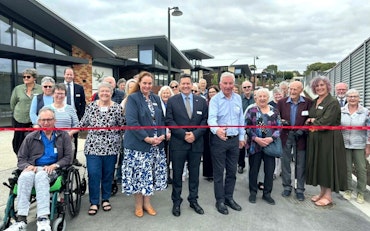The issue facing younger people with disability in aged care
Calls to action to tackle the “complex issue” of younger people with disability being housed in residential aged care homes have been brought to the forefront, thanks to a new report.

Younger people with disability living in aged care has been flagged as an issue in the latest NDIS Report Card by the Summer Foundation (Source: Shutterstock)
The National Disability Insurance Scheme (NDIS) Report Card for June 2018, by the Summer Foundation, is the second report of its kind, and highlights the six most important outcomes for the NDIS to achieve for young people, with reducing the numbers living in residential aged care listed as outcome number one.
Chief Executive Officer (CEO) of the Summer Foundation, Luke Bo’sher says the report is set up as an ongoing initiative to first identify and understand the problems faced, before making it possible for positive change to occur.
“Younger people shouldn’t be living in aged care, so the six outcomes measure the extent to which the NDIS is effectively reducing the number of younger people being admitted to aged care and improving the lives of younger people already living in aged care, by facilitating their move into more appropriate housing,” he explains.
“Living in residential aged care is incredibly detrimental for a younger person with disability.
“It reduces their independence and limits their ability to reach their potential.
“It is also socially isolating: 82 percent of younger people in residential aged care rarely or never visit their friends and around 13 percent never go outside.
“This is a complex issue that occurs when younger people’s needs aren’t met by the disability, housing and health systems.
“We know that all three of these systems need to work well for a person with a complex disability to live a good life in the community.
“The gaps in disability are being fixed through the NDIS… the biggest challenge at the moment are the gaps in affordable and accessible housing [and] our biggest focus needs to be on generating more housing solutions.”
Seniors lifestyle and care provider IRT is just one group developing a “great example” of aged care and disability care co-housing called the Kemira model, which was completed in 2016.
Based on in-depth research into the limited housing options available to ageing people with intellectual disability, IRT says the model “bridges the critical gap” between aged care and disability services by keeping families together, empowering people living with intellectual disability and providing continuity in housing and support, that allows ageing people with intellectual disability to live with their primary carers in a supportive environment.
Mr Bo’sher further explains that the recent report card is a measure of the impact the NDIS is having and says subsequent reports will measure changes over time.
“This report card identifies that more than 1 in 20 younger people in residential aged care who have applied for NDIS funding have been deemed ineligible, pointing to a critical gap between the health and disability sectors that these younger people are falling through.
“It also highlights six important outcomes for the NDIS to achieve for younger people living in residential aged care.
“We believe that the solution to the issue of young people living in residential aged care has four interrelated parts.”
The four areas of focus include:
- Housing – the Summer Foundation believe the range and scale of accessible housing needs to be increased and needs to ensure that young people with disability are finding their way into these housing options
- NDIS – they also support the need for younger people with disability living in nursing homes, or at risk of entering one, to have effective NDIS plans, which include the funding they need to live as independently as possible in the community
- Pathways Home – Mr Bo’sher says the majority of younger people who enter residential aged care do so from a hospital setting, so improving the interface between the NDIS, health and aged care gateways is “critical” to prevent young people being discharged from hospitals into nursing homes.
- Community and Primary Health – he adds that people with disability and complex support needs often live within a fairly narrow margin of health [and] access to proactive health services that sustain community living for young people with disability must be increased.
National Director of Young People in Nursing Homes National Alliance, Dr Bronwyn Morkham also reflected on the report and its findings, saying that while aged care providers do their “very best”, more needs to be done for young people with disability living in nursing homes.
“The aged care system was never meant to be designed for these people,” she says.
“Generational differences, most in residential aged care facilities are in the last years of their lives and most of the people make friends and experience more death and dying, young people can’t get out of the nursing home and into the community and struggle with seeing friends [and nursing homes are] not required to provide rehabilitation services.
“Being in a nursing home is certainly not ideal… we had hoped the NDIS would make a difference here but unfortunately it has caused a lot of problems for this group.”
Dr Morkham says that the NDIS really needs to step up and “equip its obligations” for younger people living in nursing homes.
“We don’t have places for people to move, we don’t have the services these people need to live safely and maintain their health and wellbeing within the community… a skilled workforce is needed,” she says.
“The bricks and mortar is one part but unless you’ve got the care model right… we need to do a lot more work with local councils – building accessible houses for people with disability and ageing in their community.
“We need to look further than the disability sector to solve this problem.”
The full NDIS Report Card for June 2018 is available to view online.










